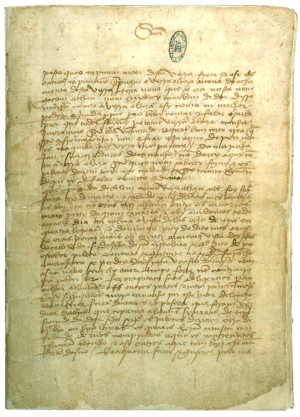Pêro Vaz de Caminha facts for kids
Quick facts for kids
Pêro Vaz de Caminha
|
|
|---|---|

1500' letter to Manuel I of Portugal by Pêro Vaz de Caminha.
|
|
| Born | c.1450 |
| Died | 15 December 1500 Calicut, India
|
| Nationality | Portuguese |
| Occupation | Knight, writer, secretary |
| Known for | Writer of the official report of the discovery of Brazil. |
| Signature | |
Pêro Vaz de Caminha (born around 1450, died December 15, 1500) was a Portuguese knight. He sailed with Pedro Álvares Cabral to India in the year 1500. Caminha worked as a secretary for the Portuguese trading post. He is famous for writing the first official report about the discovery of Brazil. This important letter, called the Carta de Pêro Vaz de Caminha, was written on May 1, 1500. Pêro Vaz de Caminha sadly died in a conflict in Calicut, India, later that same year.
Contents
Life and Early Career of Pêro Vaz de Caminha
Pêro Vaz de Caminha was the son of Vasco Fernandes de Caminha. His father was also a knight in the household of a powerful duke. Caminha's family were among the first people to settle in a town called Neiva.
In 1476, Pêro Vaz de Caminha received an important job. He became the "master of the scale" at the royal mint in Porto. A mint is a place where coins are made. This job was one of many that his father had held. The letter about his appointment called him a knight of the royal household. This suggests he may have fought alongside King Afonso V of Portugal in a battle.
In 1497, Caminha was chosen for another important role. He helped write the rules for the Porto City Council. These rules were then presented to the Cortes in Lisbon. The Cortes was a kind of parliament or meeting of important people.
Journey to India and the Discovery of Brazil
In 1500, Pêro Vaz de Caminha was chosen for a big adventure. Even though he was older, he was made secretary for a new trading post. This trading post was planned for Calicut, India. He would work under a royal merchant named Aires Correia.
Caminha and Correia sailed on the main ship of the second fleet to India. This fleet was led by Pedro Álvares Cabral. They left Lisbon in March 1500. The ships sailed far out into the Atlantic Ocean. On April 22, 1500, they unexpectedly found a large landmass. This land was Brazil.
The fleet stopped near a place now called Porto Seguro, Bahia. They spent about a week there. The Portuguese explorers met and interacted with the local Tupiniquim native people. After this time, the fleet got ready to continue their journey to India.
Pêro Vaz de Caminha's Famous Letter
Before leaving Brazil, Cabral gave Pêro Vaz de Caminha a special task. He asked Caminha to write a letter to King Manuel I of Portugal. This letter was to officially report the discovery of this new land. At first, they thought it was an island.
Caminha's letter, known as the Carta de Pêro Vaz de Caminha, is very detailed. It describes everything that had happened on the trip so far. It also describes the new land and the people they had met. Caminha dated his letter May 1st. He signed it from "this Safe Harbor of your island of the True Cross". Cabral had named the place "Vera Cruz" (True Cross) in honor of a religious holiday.
Caminha's official report and another letter were sent back to Portugal. They were given to one of Cabral's captains. The rest of the fleet left Brazil on May 3, 1500. They sailed towards the Cape of Good Hope and then on to India.
Pêro Vaz de Caminha's letter is often called the "birth certificate" of Brazil. It is a very important historical document. However, the Portuguese government kept reports of new discoveries secret for a long time. Caminha's letter was not published until the 1800s.
Death in Calicut, India
The Portuguese fleet arrived in India in September 1500. They reached the Malabar Coast and set up their trading post in Calicut. Caminha began his duties as the secretary there.
Soon, problems started between the Portuguese traders and the Arab merchants. The Arabs had been trading in Calicut for a long time. The Portuguese found it hard to sell their goods. They thought the Arabs were working together to stop them from trading spices. The local ruler, the Zamorin of Calicut, did not get involved.
The Portuguese leader, Aires Correia, became very frustrated. In late December 1500, the Portuguese started taking spices from Arab boats in the harbor. This led to a big fight on the docks. Mobs from Calicut attacked the Portuguese trading post. They killed many Portuguese people they found there. About 50 to 70 Portuguese died in this conflict. This included Aires Correia and, it is believed, Pêro Vaz de Caminha.
A year later, King Manuel I of Portugal wrote a letter. In it, he appointed Caminha's grandson to his grandfather's old job at the Porto mint. The king clearly stated that Pêro Vaz de Caminha had "died in India."
See also
 In Spanish: Pêro Vaz de Caminha para niños
In Spanish: Pêro Vaz de Caminha para niños

